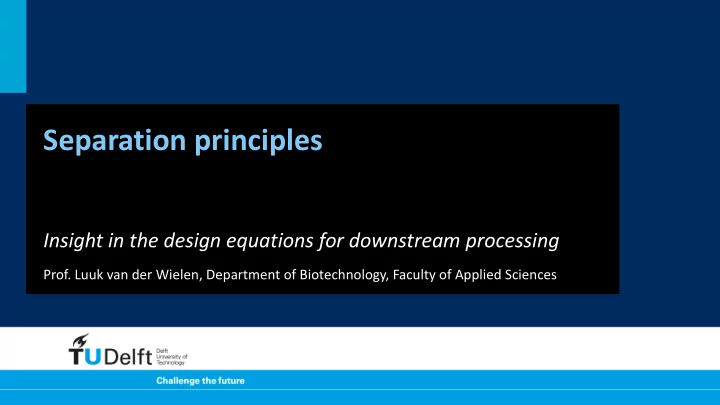

Separation principles Insight in the design equations for downstream processing Prof. Luuk van der Wielen, Department of Biotechnology, Faculty of Applied Sciences
FERMENTER cell-disruption Mechanical separations cell removal (including solid particles) concentration Molecular separations (dissolved molecules only) purification formulation let’s tackle these first! MARKET
Important concept: equilibrium stage S = Separation (extraction) factor V • appears in adsorption, absorption, stripping x 0 y 1 ‘0’ 1 • describes ratio of transport capacities • indicates how much auxiliary phase (V) is x 1 y 2 ‘2’ required per amount of feed! • capacity of auxiliary phase goes on top L assumption: outgoing flows at equilibrium
Important concept: equilibrium stage 100 V x 0 y 1 ‘0’ extract feed Yield % ‘1’ 0 x 1 y 2 1 3 0 ‘2’ 2 raffinate solvent Separation factor S L ‘in’ via ‘in’ via’ ‘out’ via ‘out’ via + = + feed solvent raffinate extract
Multi-stage and countercurrent V, y 1 Solving mass balances for N number of stages, using the L, x 0 equilibrium relation y = K x 1 y 2 x 1 2 N=10 y 3 x 2 100 Adding more stages increases N=5 the yield! N=2 N -1 Yield % N=1 y N x N -1 N Number of stages N 0 S V, y N +1 L, x N 1 3 0 2
Relating to economy – the rough explanation S à Indicates costs of auxiliary phase per amount of feedstock (V/L) and thus affects operational expenditures ( OPEX , €) N à Adding stages requires investment: affects capital expenditures ( CAPEX , €) total OPEX Costs For a specific yield (say 99%), we can now € calculate the required number of stages N for any separation factor S CAPEX You have to pay both ( total ) Separation factor S
Relating to economy – more detail CAPEX-estimates can come from • Comparable plant (somewhere else) Experience or rules of thumb • • Such as: 100 M$ for 100 kton per annum liquid volume capacity Increased • Solids handling plants twice as expensive accuracy Short-cut design (back of envelope calculation) • • Detailed design Fundamental calculations •
Multi-stage and countercurrent V, y 1 L, x 0 ‘in’ via ‘in’ via’ ‘out’ via ‘out’ via 1 + = + feed solvent raffinate extract y 2 x 1 2 Try to design for most efficient solvent use (V min ) y 3 x 2 • feed ‘in’ = extract ‘out’ Lx 0 = Vy 1 • highest concentration feed x 1 = x 0 N -1 • at equilibrium Lx 0 = VKx 0 y N x N -1 N S min = 1 but N 8 L, x N V, y N +1
Separation factor indicates direction of transport N=10 100 N=5 N=2 Yield % N=1 0 S 1 3 0 2 S < 1 S > 1 product ‘moves’ with feed L product ‘moves’ with solvent V
Multi-stage and countercurrent A V, y 1 L, x 0 • Use differences in S to separate multiple components 1 • Feed stage in between top section and bottom section y 2 x 1 2 • If component A has bigger affinity for V than component B then: y 3 x 2 • K A > K B • A moves ‘up’ with V if: S A (top) > 1, and S A (bottom) > 1 N -1 • B moves ‘down’ with L if: S B (top) < 1, and S B (bottom) < 1 y N x N -1 N L, x N V, y N +1 B
Multi-stage and countercurrent stripping V, y 1 L, x 0 1 V L y 2 x 1 absorption back-extraction 2 L L’ y 3 x 2 extraction dissolve L Crystal N -1 crystallisation y N desorption x N -1 N V/L Sorbent adsorption L, x N V, y N +1
Mechanical separations Feedstream F Supernatant or filtrate Contains particles (cells, crystals etc) Contains solutes and dissolved molecules (solutes) = F – C – αC F α depends on the choice of mechanical separation C Wet cells = cells (C) + cells with adherent solution ( αC) including αC solutes
Equilibrium stage for mechanical separation V, y 1 V, y 2 F – (1+ α )C, c F V,y F – (1+ α )C, c F α C, cF L,x C L, x 0 L, x 1 F,C, c F (1+ α )C, c
Mechanical separations often include countercurrent wash W Same approach as for countercurrent molecular V, y 1 L, x 0 separations with: 1 y 2 x 1 L = (1+α)C and V = F – (1+α)C + W 2 y 3 N=10 x 2 100 N=5 N -1 N=2 Yield % N=1 y N x N -1 N 0 L, x N V, y N +1 S 0 1 3 2
Design recipe (always works) mass balance (overall, phase, local) out in phase and reaction equilibria ( K ’s) rate equilibrium hydrodynamics in out mass transfer and reaction rate ( k ’s) mass balance
Design recipe (always works) 1+2) how much beans, water & energy? mass balance (overall, phase, local) out in phase and reaction equilibria ( K ’s) rate equilibrium hydrodynamics in out mass transfer and reaction rate ( k ’s) mass balance
Design recipe (always works) 1+2) how much beans, water & energy? mass balance (overall, phase, local) out in phase and reaction equilibria ( K ’s) rate equilibrium hydrodynamics in out mass transfer and reaction rate ( k ’s) 3) how big of a coffee maker do you need? mass balance (even: how big a power plant to operate it?)
See you next unit
Recommend
More recommend